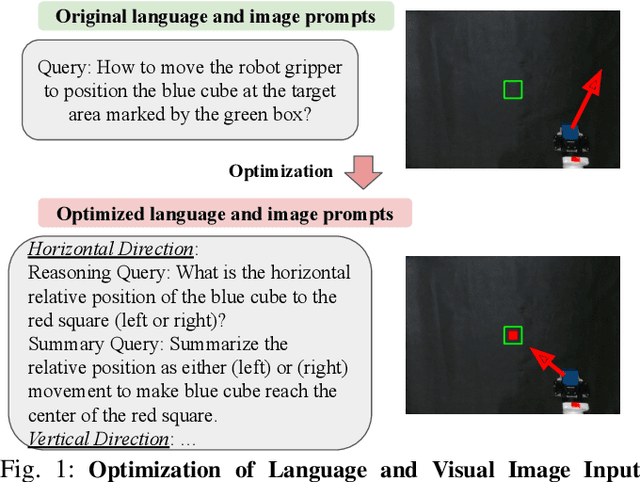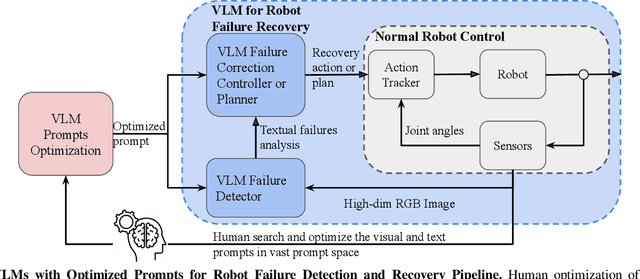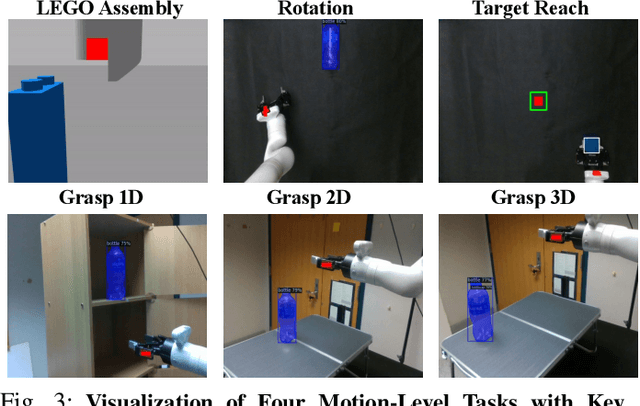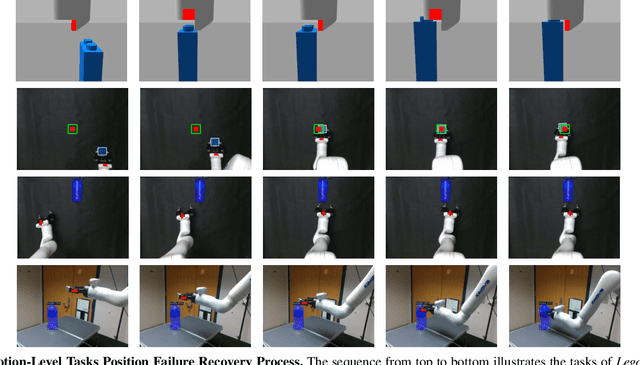Hongyi Chen
Web2Grasp: Learning Functional Grasps from Web Images of Hand-Object Interactions
May 07, 2025Abstract:Functional grasp is essential for enabling dexterous multi-finger robot hands to manipulate objects effectively. However, most prior work either focuses on power grasping, which simply involves holding an object still, or relies on costly teleoperated robot demonstrations to teach robots how to grasp each object functionally. Instead, we propose extracting human grasp information from web images since they depict natural and functional object interactions, thereby bypassing the need for curated demonstrations. We reconstruct human hand-object interaction (HOI) 3D meshes from RGB images, retarget the human hand to multi-finger robot hands, and align the noisy object mesh with its accurate 3D shape. We show that these relatively low-quality HOI data from inexpensive web sources can effectively train a functional grasping model. To further expand the grasp dataset for seen and unseen objects, we use the initially-trained grasping policy with web data in the IsaacGym simulator to generate physically feasible grasps while preserving functionality. We train the grasping model on 10 object categories and evaluate it on 9 unseen objects, including challenging items such as syringes, pens, spray bottles, and tongs, which are underrepresented in existing datasets. The model trained on the web HOI dataset, achieving a 75.8% success rate on seen objects and 61.8% across all objects in simulation, with a 6.7% improvement in success rate and a 1.8x increase in functionality ratings over baselines. Simulator-augmented data further boosts performance from 61.8% to 83.4%. The sim-to-real transfer to the LEAP Hand achieves a 85% success rate. Project website is at: https://webgrasp.github.io/.
A Survey of Large Language Model-Powered Spatial Intelligence Across Scales: Advances in Embodied Agents, Smart Cities, and Earth Science
Apr 14, 2025Abstract:Over the past year, the development of large language models (LLMs) has brought spatial intelligence into focus, with much attention on vision-based embodied intelligence. However, spatial intelligence spans a broader range of disciplines and scales, from navigation and urban planning to remote sensing and earth science. What are the differences and connections between spatial intelligence across these fields? In this paper, we first review human spatial cognition and its implications for spatial intelligence in LLMs. We then examine spatial memory, knowledge representations, and abstract reasoning in LLMs, highlighting their roles and connections. Finally, we analyze spatial intelligence across scales -- from embodied to urban and global levels -- following a framework that progresses from spatial memory and understanding to spatial reasoning and intelligence. Through this survey, we aim to provide insights into interdisciplinary spatial intelligence research and inspire future studies.
Sample-efficient diffusion-based control of complex nonlinear systems
Feb 25, 2025Abstract:Complex nonlinear system control faces challenges in achieving sample-efficient, reliable performance. While diffusion-based methods have demonstrated advantages over classical and reinforcement learning approaches in long-term control performance, they are limited by sample efficiency. This paper presents SEDC (Sample-Efficient Diffusion-based Control), a novel diffusion-based control framework addressing three core challenges: high-dimensional state-action spaces, nonlinear system dynamics, and the gap between non-optimal training data and near-optimal control solutions. Through three innovations - Decoupled State Diffusion, Dual-Mode Decomposition, and Guided Self-finetuning - SEDC achieves 39.5\%-49.4\% better control accuracy than baselines while using only 10\% of the training samples, as validated across three complex nonlinear dynamic systems. Our approach represents a significant advancement in sample-efficient control of complex nonlinear systems. The implementation of the code can be found at https://anonymous.4open.science/r/DIFOCON-C019.
Structure-prior Informed Diffusion Model for Graph Source Localization with Limited Data
Feb 25, 2025Abstract:The source localization problem in graph information propagation is crucial for managing various network disruptions, from misinformation spread to infrastructure failures. While recent deep generative approaches have shown promise in this domain, their effectiveness is limited by the scarcity of real-world propagation data. This paper introduces SIDSL (\textbf{S}tructure-prior \textbf{I}nformed \textbf{D}iffusion model for \textbf{S}ource \textbf{L}ocalization), a novel framework that addresses three key challenges in limited-data scenarios: unknown propagation patterns, complex topology-propagation relationships, and class imbalance between source and non-source nodes. SIDSL incorporates topology-aware priors through graph label propagation and employs a propagation-enhanced conditional denoiser with a GNN-parameterized label propagation module (GNN-LP). Additionally, we propose a structure-prior biased denoising scheme that initializes from structure-based source estimations rather than random noise, effectively countering class imbalance issues. Experimental results across four real-world datasets demonstrate SIDSL's superior performance, achieving 7.5-13.3% improvements in F1 scores compared to state-of-the-art methods. Notably, when pretrained with simulation data of synthetic patterns, SIDSL maintains robust performance with only 10% of training data, surpassing baselines by more than 18.8%. These results highlight SIDSL's effectiveness in real-world applications where labeled data is scarce.
MCSFF: Multi-modal Consistency and Specificity Fusion Framework for Entity Alignment
Oct 18, 2024



Abstract:Multi-modal entity alignment (MMEA) is essential for enhancing knowledge graphs and improving information retrieval and question-answering systems. Existing methods often focus on integrating modalities through their complementarity but overlook the specificity of each modality, which can obscure crucial features and reduce alignment accuracy. To solve this, we propose the Multi-modal Consistency and Specificity Fusion Framework (MCSFF), which innovatively integrates both complementary and specific aspects of modalities. We utilize Scale Computing's hyper-converged infrastructure to optimize IT management and resource allocation in large-scale data processing. Our framework first computes similarity matrices for each modality using modality embeddings to preserve their unique characteristics. Then, an iterative update method denoises and enhances modality features to fully express critical information. Finally, we integrate the updated information from all modalities to create enriched and precise entity representations. Experiments show our method outperforms current state-of-the-art MMEA baselines on the MMKG dataset, demonstrating its effectiveness and practical potential.
Automating Robot Failure Recovery Using Vision-Language Models With Optimized Prompts
Sep 06, 2024



Abstract:Current robot autonomy struggles to operate beyond the assumed Operational Design Domain (ODD), the specific set of conditions and environments in which the system is designed to function, while the real-world is rife with uncertainties that may lead to failures. Automating recovery remains a significant challenge. Traditional methods often rely on human intervention to manually address failures or require exhaustive enumeration of failure cases and the design of specific recovery policies for each scenario, both of which are labor-intensive. Foundational Vision-Language Models (VLMs), which demonstrate remarkable common-sense generalization and reasoning capabilities, have broader, potentially unbounded ODDs. However, limitations in spatial reasoning continue to be a common challenge for many VLMs when applied to robot control and motion-level error recovery. In this paper, we investigate how optimizing visual and text prompts can enhance the spatial reasoning of VLMs, enabling them to function effectively as black-box controllers for both motion-level position correction and task-level recovery from unknown failures. Specifically, the optimizations include identifying key visual elements in visual prompts, highlighting these elements in text prompts for querying, and decomposing the reasoning process for failure detection and control generation. In experiments, prompt optimizations significantly outperform pre-trained Vision-Language-Action Models in correcting motion-level position errors and improve accuracy by 65.78% compared to VLMs with unoptimized prompts. Additionally, for task-level failures, optimized prompts enhanced the success rate by 5.8%, 5.8%, and 7.5% in VLMs' abilities to detect failures, analyze issues, and generate recovery plans, respectively, across a wide range of unknown errors in Lego assembly.
KOROL: Learning Visualizable Object Feature with Koopman Operator Rollout for Manipulation
Jun 29, 2024Abstract:Learning dexterous manipulation skills presents significant challenges due to complex nonlinear dynamics that underlie the interactions between objects and multi-fingered hands. Koopman operators have emerged as a robust method for modeling such nonlinear dynamics within a linear framework. However, current methods rely on runtime access to ground-truth (GT) object states, making them unsuitable for vision-based practical applications. Unlike image-to-action policies that implicitly learn visual features for control, we use a dynamics model, specifically the Koopman operator, to learn visually interpretable object features critical for robotic manipulation within a scene. We construct a Koopman operator using object features predicted by a feature extractor and utilize it to auto-regressively advance system states. We train the feature extractor to embed scene information into object features, thereby enabling the accurate propagation of robot trajectories. We evaluate our approach on simulated and real-world robot tasks, with results showing that it outperformed the model-based imitation learning NDP by 1.08$\times$ and the image-to-action Diffusion Policy by 1.16$\times$. The results suggest that our method maintains task success rates with learned features and extends applicability to real-world manipulation without GT object states.
Artificial Intelligence for Complex Network: Potential, Methodology and Application
Feb 23, 2024Abstract:Complex networks pervade various real-world systems, from the natural environment to human societies. The essence of these networks is in their ability to transition and evolve from microscopic disorder-where network topology and node dynamics intertwine-to a macroscopic order characterized by certain collective behaviors. Over the past two decades, complex network science has significantly enhanced our understanding of the statistical mechanics, structures, and dynamics underlying real-world networks. Despite these advancements, there remain considerable challenges in exploring more realistic systems and enhancing practical applications. The emergence of artificial intelligence (AI) technologies, coupled with the abundance of diverse real-world network data, has heralded a new era in complex network science research. This survey aims to systematically address the potential advantages of AI in overcoming the lingering challenges of complex network research. It endeavors to summarize the pivotal research problems and provide an exhaustive review of the corresponding methodologies and applications. Through this comprehensive survey-the first of its kind on AI for complex networks-we expect to provide valuable insights that will drive further research and advancement in this interdisciplinary field.
Social Physics Informed Diffusion Model for Crowd Simulation
Feb 08, 2024



Abstract:Crowd simulation holds crucial applications in various domains, such as urban planning, architectural design, and traffic arrangement. In recent years, physics-informed machine learning methods have achieved state-of-the-art performance in crowd simulation but fail to model the heterogeneity and multi-modality of human movement comprehensively. In this paper, we propose a social physics-informed diffusion model named SPDiff to mitigate the above gap. SPDiff takes both the interactive and historical information of crowds in the current timeframe to reverse the diffusion process, thereby generating the distribution of pedestrian movement in the subsequent timeframe. Inspired by the well-known social physics model, i.e., Social Force, regarding crowd dynamics, we design a crowd interaction module to guide the denoising process and further enhance this module with the equivariant properties of crowd interactions. To mitigate error accumulation in long-term simulations, we propose a multi-frame rollout training algorithm for diffusion modeling. Experiments conducted on two real-world datasets demonstrate the superior performance of SPDiff in terms of macroscopic and microscopic evaluation metrics. Code and appendix are available at https://github.com/tsinghua-fib-lab/SPDiff.
Planning with Sequence Models through Iterative Energy Minimization
Mar 28, 2023Abstract:Recent works have shown that sequence modeling can be effectively used to train reinforcement learning (RL) policies. However, the success of applying existing sequence models to planning, in which we wish to obtain a trajectory of actions to reach some goal, is less straightforward. The typical autoregressive generation procedures of sequence models preclude sequential refinement of earlier steps, which limits the effectiveness of a predicted plan. In this paper, we suggest an approach towards integrating planning with sequence models based on the idea of iterative energy minimization, and illustrate how such a procedure leads to improved RL performance across different tasks. We train a masked language model to capture an implicit energy function over trajectories of actions, and formulate planning as finding a trajectory of actions with minimum energy. We illustrate how this procedure enables improved performance over recent approaches across BabyAI and Atari environments. We further demonstrate unique benefits of our iterative optimization procedure, involving new task generalization, test-time constraints adaptation, and the ability to compose plans together. Project website: https://hychen-naza.github.io/projects/LEAP
 Add to Chrome
Add to Chrome Add to Firefox
Add to Firefox Add to Edge
Add to Edge